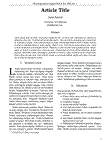Resultados de búsqueda - (((ligur OR (line OR like)) OR ((ligan OR (ligas OR livas)) OR liga)) OR sigue) 1
Materias dentro de su búsqueda.
Materias dentro de su búsqueda.
- Mexico 7
- México 5
- 3
- Educación 3
- Estrategia 3
- Estudiantes 3
- I21 3
- Scrap 3
- Strategy 3
- government 3
- 5 why 2
- Aprendizaje 2
- COVID-19 2
- Caos 2
- Chaos 2
- Comportamiento 2
- Covid-19 2
- Depresión 2
- Depression 2
- Docente 2
- Education 2
- Equifinalidad 2
- Equifinality 2
- España 2
- Estratificación 2
- Estructura 2
- Exclusión 2
- Filosofía 2
- Innovación 2
- Innovation 2
-
541
-
542
-
543
-
544
-
545
-
546
-
547
-
548
Etiología de neumonías virales diagnosticadas con reacción en cadena de la polimerasa en niños menores de 2 años
Publicado 2023“…RESULTADOS Se revisaron un total de 462 expedientes clínicos con diagnóstico de neumonía viral entre tres revisores independientes, de los cuales el 54.1% eran masculinos. El agente etiológico que se encontró con mayor prevalencia fue Rinovirus- Enterovirus en el 9.1%, seguido del Virus Sincitial Respiratorio en el 8.2%. …”
Enlace del recurso
Tesis -
549
-
550
-
551
-
552
Organización ecológica de un gremio de saurios en las dunas de arena de Viesca, Coahuila, México
Publicado 2006“…It was observed a narrow association between each lizard’s species and one of the resources considered in this study: Uta stejnegeri with the perennial plant Suaeda nigrescens (that provide benefits for its survivorship like thermal and physical refuge, feeding, and potential nesting sites), U. exsul with the loose sand depth (having morphologic and ethological specialized adaptations to develop its activities in this substrate), and A. marmorata with the sand’s temperature and time (to carry out its characteristic foraging mode, it must reach and maintain a high body temperature which obtains from the environment). …”
Enlace del recurso
Tesis -
553
Organización ecológica de un gremio de saurios en las dunas de arena de Viesca, Coahuila, México
Publicado 2006“…It was observed a narrow association between each lizard’s species and one of the resources considered in this study: Uta stejnegeri with the perennial plant Suaeda nigrescens (that provide benefits for its survivorship like thermal and physical refuge, feeding, and potential nesting sites), U. exsul with the loose sand depth (having morphologic and ethological specialized adaptations to develop its activities in this substrate), and A. marmorata with the sand’s temperature and time (to carry out its characteristic foraging mode, it must reach and maintain a high body temperature which obtains from the environment). …”
Enlace del recurso
Tesis -
554
-
555
-
556
Macro Mineral Content in Five Shrubs Browsed by White-Tailed Deer (Odocoileus virginianus), Northeastern Mexico
Publicado 2012“…Seasonal variations in minerals could be associated to climatic conditions like excessive irradiance levels during Summer and extreme low temperatures in Winter and rainfall events.…”
Enlace del recurso
Artículo -
557
-
558
-
559
-
560
Revisión del proceso de la administración estratégica, estudio del paradigma de estrategia, estructura y equifinalidad: una investigación empírica en empresas en noreste de México...
Publicado 2005“…The second and more important one is that the equifinality paradigm was in fact true and empirical evidence was obtained. …”
Enlace del recurso
Artículo


